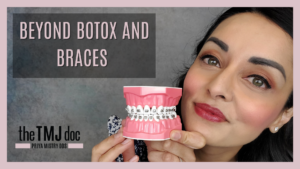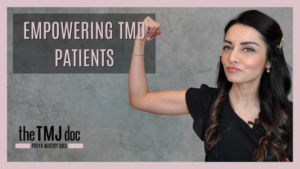In a recent episode of The Unclenched Podcast, Dr. Priya Mistry—known as “The TMJ Doc”—was joined by fellow TMJ expert Dr. Alex for a Q&A session tackling real questions from patients and listeners. Together, they explored a wide range of TMJ-related topics, including orthotics, bite changes, vision issues, dizziness, and the ever-frustrating “wonky jaw.”
Here’s a closer look at the insights they shared.
Life Update: Tongue Tie Surgery Success
Dr. Mistry opened the episode with a personal update. Her young son recently underwent tonsil, adenoid, and tongue-tie removal surgery. Recovery was tough, but the results were immediate—especially in his ability to pronounce “R” and “L” sounds more clearly. As both a mother and a clinician, Dr. Mistry found the experience deeply rewarding and reaffirming of the importance of early intervention.
Understanding TMJ Orthotics vs. Night Guards
Many patients are confused about the difference between night guards, bite splints, and TMJ orthotics. Dr. Mistry emphasized that orthotics used for TMJ treatment are worn full-time—22 hours a day, 7 days a week (except when eating)—to create lasting change in the jaw joints and muscles. She and Dr. Alex discussed the importance of following up Phase One (orthotic therapy) with Phase Two treatment, which stabilizes the bite long-term through orthodontics or reconstruction. Without Phase Two, symptoms often return.
Dr. Mistry noted that her team is currently searching for a dentist trained in Phase Two therapy to join her practice.
Can TMJ Affect Vision?
According to both doctors, yes—sometimes. In some cases, patients have reported improvements in blurry vision once TMJ treatment begins. This may be due to the role of the sphenoid bone (which cradles the brain) and its connection to jaw muscles like the pterygoids. However, not all vision changes are TMJ-related, and individual anatomy varies. A proper diagnosis is essential.
Bite Changes After Orthotic Use
When a patient notices their bite feels different after wearing an orthotic, it’s often a sign that their joints and muscles have moved into a more optimal position. That’s a good thing. However, it typically means Phase Two treatment will be necessary to maintain that new alignment. Dr. Mistry highlighted the importance of ongoing care and reassessment throughout treatment.
Discomfort in Front Teeth from a Sleep Appliance
Some listeners shared concerns about tenderness in their lower front teeth after wearing their sleep appliance. Dr. Mistry explained this often comes down to improper fit or bite contact. Fortunately, these issues are usually fixable with an appliance adjustment. Her advice: don’t ignore discomfort—it’s the body’s way of signaling something isn’t quite right.
What to Do If You Can’t See Dr. Mistry In Person
For those unable to visit her Vancouver, WA practice, Dr. Mistry recommends using the ICCMO website to find a neuromuscularly trained dentist in their area. She also encourages patients to watch her YouTube video, “Questions to Ask Your TMJ Dentist,” which offers tips on choosing a provider with the right training and approach.
Acupuncture and the “Wonky Jaw”
While acupuncture, meditation, and craniosacral therapy can be valuable complementary tools, Dr. Mistry made it clear: they won’t realign a jaw that’s visibly off. A structural problem requires a structural solution—usually in the form of a TMJ orthotic and related treatments like DTR (Disclusion Time Reduction) or T-Scan bite balancing.
Dizziness and Feeling Off-Balance: A TMJ Symptom?
Yes, dizziness or a sense of imbalance can absolutely stem from jaw issues. Dr. Mistry and Dr. Alex have seen patients regain stability through proper jaw positioning. In complex cases, collaboration with chiropractors, physical therapists, or craniosacral therapists may enhance outcomes.
What Causes Clenching—Stress or Airway?
It can be both. Clenching and grinding may stem from psychological stress, a restricted airway (such as sleep apnea), or an imbalanced bite. In many cases, Dr. Mistry has seen patients stop clenching entirely after receiving orthotic therapy or bite balancing. Identifying and treating the root cause is the goal.
TMJ or Trigeminal Neuralgia?
It’s a question Dr. Mistry hears often. Trigeminal neuralgia (TN) and TMJ disorders can share overlapping symptoms, which leads to frequent misdiagnoses. If a patient experiences significant improvement from TMJ treatment, it’s a strong indicator that the pain was not true TN. Accurate diagnosis is critical—and unfortunately, not always easy.
Disc Displacement: Don’t Ignore the Signs
One listener shared a story about jaw locking and being told it was “just muscular.” Later, they independently pursued an MRI, which confirmed a displaced disc. Dr. Mistry sympathized with the experience and emphasized how crucial imaging and proper diagnosis can be. Unlocking a jaw can take days—or over a year—but consistent care and the right approach can make all the difference.
Final Thoughts
Dr. Mistry and Dr. Alex closed the episode by reminding listeners that TMJ disorders are complex, but treatable. With the right provider and a customized treatment plan, relief is possible. Whether you’re dealing with jaw pain, bite changes, vision problems, or dizziness, help is out there—and healing starts with the right questions.
Dr. Priya Mistry is a TMJ-focused dentist based in Vancouver, WA. Through her practice, TMJ Dental Doc, she provides non-invasive, neuromuscular dentistry solutions for patients suffering from TMJ disorders and chronic facial pain.







